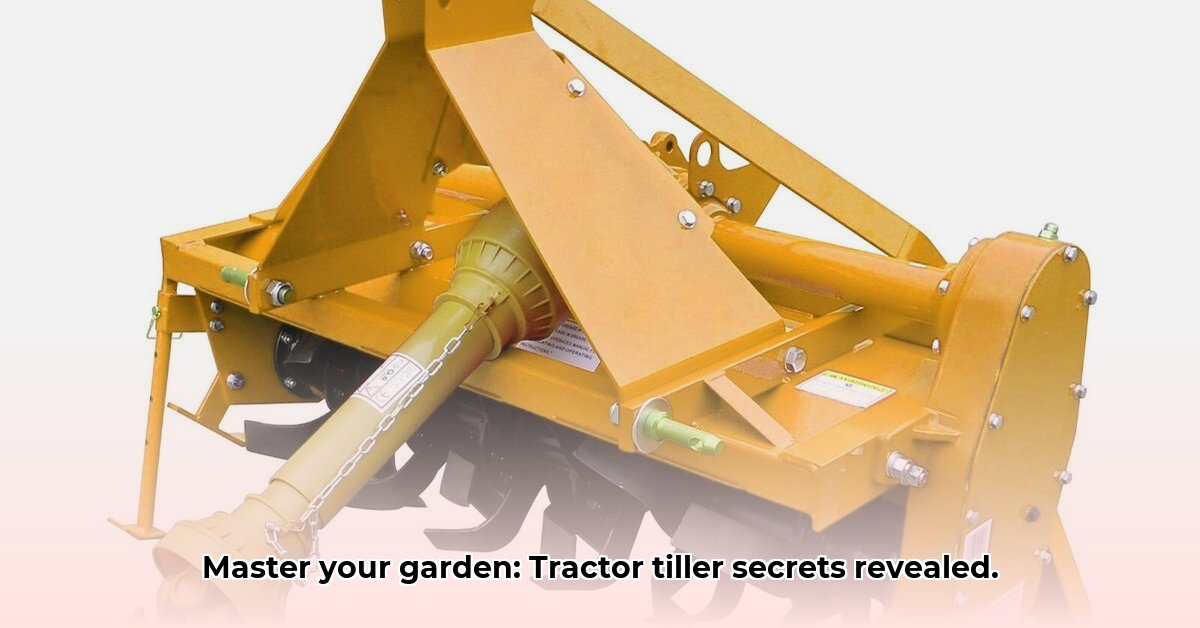
Thinking about simplifying and boosting the efficiency of your farm work? A tractor-mounted tiller might be the perfect solution. This comprehensive guide covers everything from selecting the ideal tiller to ensuring its smooth operation, offering insights valuable to both seasoned professionals and newcomers alike. We delve into the different tiller types, safe operation techniques, and essential maintenance practices to maximize your land's potential and extend the life of your equipment. Let's get started! For more information on tractor mounted tillers, check out this helpful resource.
Understanding Your Tilling Options: Choosing the Right Tractor Mounted Tiller
Selecting the right tractor-mounted tiller is crucial for optimal results. The perfect tiller depends entirely on your specific needs and the characteristics of your land. Let's explore some key tiller types:
Rotary Tillers: These versatile tillers handle a wide range of soil types effectively. Ideal for seedbed preparation and general tillage, they are the equivalent of a multi-tool for tilling. However, they might operate slower than some alternatives and demand more consistent maintenance.
Offset Tillers: Offering precision, these tillers are perfect for working near obstacles like fences or trees. They provide excellent control, but typically cover less ground per pass and may be less adaptable to varying soil conditions compared to rotary tillers.
Heavy-Duty Tillers: Designed for challenging terrains and tough soils, these robust tillers are built for the most demanding tasks. They require powerful tractors and come with a higher upfront cost, but their strength makes them ideal for rocky or exceptionally hard ground.
Light-Duty Tillers: These budget-friendly options are perfect for smaller gardens and lighter soils. They are easy to use but are less powerful, making them unsuitable for extensive or heavy-duty tilling operations.
Here's a comparison to help you visualize the differences:
| Tiller Type | Pros | Cons | Best For |
|---|---|---|---|
| Rotary | Versatile, suitable for most soil types, user-friendly | Can be slower, demands more maintenance | General tillage, seedbed preparation |
| Offset | Precision, ideal for close-quarters work | Less versatile, smaller working width, often more expensive | Working around obstacles, smaller fields, precision work |
| Heavy-duty | Powerful, handles tough soils | Expensive, needs a high-horsepower tractor | Large fields, rocky or very hard soils |
| Light-duty | Affordable, user-friendly | Less powerful, not suited for heavy-duty tasks | Smaller fields, lighter soils, less demanding use |
Matching Your Tiller to Your Tractor: A Powerful Partnership
Choosing a compatible tiller and tractor is vital for efficient operation. Using an inappropriately sized tiller can lead to decreased efficiency or even damage to your equipment. Consider these factors:
- Horsepower: The tractor must provide sufficient horsepower to power the tiller effectively. Insufficient power can bog down the tractor and damage the tiller, while excessive power is inefficient and unnecessary.
- Tiller Width: A wider tiller increases efficiency in large fields but demands higher horsepower. Select a tilling width appropriate for your tractor and land size.
- Features: Adjustable depth settings allow customization to your soil's needs. Transport wheels simplify movement, while safety features like PTO shields are crucial for accident prevention. Do you need these features? This is a key question to ask.
Tilling Time: A Step-by-Step Guide to Safe and Efficient Operation
Prioritize safety. Always thoroughly review your owner's manual before starting. Here's a step-by-step guide:
Pre-Operation Checklist: Inspect the tiller for damage, ensure proper PTO engagement, and check fluid levels. This simple check can prevent costly future fixes.
The First Pass: Begin slowly at a shallow depth, gradually increasing speed and depth as you become more comfortable.
Overlapping Passes: Slightly overlap passes for even tillage, preventing untilled strips.
Depth Adjustment: Adjust tilling depth as necessary using the controls. Deeper tilling typically demands more power.
Turning: Turn smoothly and carefully. Abrupt changes in direction can damage the tiller and compromise tilling depth consistency.
Safety Gear: Always wear appropriate safety gear, including eye protection, hearing protection, sturdy footwear, and long sleeves and pants. Never operate machinery when tired or impaired.
Maintaining Your Investment: Keeping Your Tiller Running Smoothly
Regular maintenance is essential to prolong the life of your tiller and avoid costly repairs.
- Lubrication: Regularly lubricate moving parts per the manufacturer's instructions to prevent wear and tear.
- Inspection: Regularly inspect tines, belts, and other components for damage. Addressing small issues early can prevent bigger problems later.
- Tightening Bolts: Loose bolts are frequently the source of tiller issues. Regularly check and tighten all bolts.
Common Problems and Troubleshooting:
Common tiller problems include broken tines, PTO shaft issues, and bearing problems. Refer to your owner's manual for troubleshooting steps, or consult a qualified mechanic if needed. Have you experienced any of these issues?
By following these guidelines, you can ensure efficient and safe tilling for years to come. A well-maintained tiller is an invaluable asset. Remember: proactive maintenance and safe operation are key to optimizing its performance and lifespan.